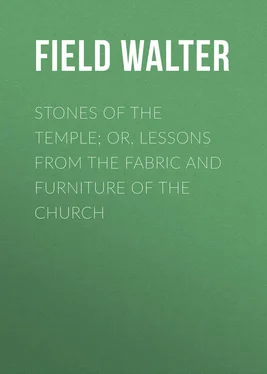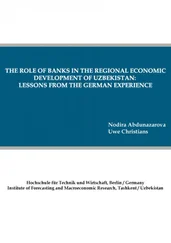Walter Field - Stones of the Temple; Or, Lessons from the Fabric and Furniture of the Church
Здесь есть возможность читать онлайн «Walter Field - Stones of the Temple; Or, Lessons from the Fabric and Furniture of the Church» — ознакомительный отрывок электронной книги совершенно бесплатно, а после прочтения отрывка купить полную версию. В некоторых случаях можно слушать аудио, скачать через торрент в формате fb2 и присутствует краткое содержание. Жанр: foreign_religion, Религиозная литература, foreign_antique, foreign_prose, на английском языке. Описание произведения, (предисловие) а так же отзывы посетителей доступны на портале библиотеки ЛибКат.
- Название:Stones of the Temple; Or, Lessons from the Fabric and Furniture of the Church
- Автор:
- Жанр:
- Год:неизвестен
- ISBN:нет данных
- Рейтинг книги:4 / 5. Голосов: 1
-
Избранное:Добавить в избранное
- Отзывы:
-
Ваша оценка:
- 80
- 1
- 2
- 3
- 4
- 5
Stones of the Temple; Or, Lessons from the Fabric and Furniture of the Church: краткое содержание, описание и аннотация
Предлагаем к чтению аннотацию, описание, краткое содержание или предисловие (зависит от того, что написал сам автор книги «Stones of the Temple; Or, Lessons from the Fabric and Furniture of the Church»). Если вы не нашли необходимую информацию о книге — напишите в комментариях, мы постараемся отыскать её.
Stones of the Temple; Or, Lessons from the Fabric and Furniture of the Church — читать онлайн ознакомительный отрывок
Ниже представлен текст книги, разбитый по страницам. Система сохранения места последней прочитанной страницы, позволяет с удобством читать онлайн бесплатно книгу «Stones of the Temple; Or, Lessons from the Fabric and Furniture of the Church», без необходимости каждый раз заново искать на чём Вы остановились. Поставьте закладку, и сможете в любой момент перейти на страницу, на которой закончили чтение.
Интервал:
Закладка:
Walter Field
Stones of the Temple; Or, Lessons from the Fabric and Furniture of the Church
PREFACE
The following chapters are an attempt to explain in very simple language the history and use of those parts of the Church's fabric with which most persons are familiar.
They are not written with a view to assist the student of Ecclesiastical Art and Architecture – for which purpose the works of many learned writers are available – but simply to inform those who, from having paid little attention to such pursuits, or from early prejudice, may have misconceived the origin and design of much that is beautiful and instructive in God's House.
The spiritual and the material fabric are placed side by side, and the several offices and ceremonies of the Church as they are specially connected with the different parts of the building are briefly noticed.
Some of the subjects referred to may appear trifling and unimportant; those, however, among them which seem to be the most trivial have in some parishes given rise to long and serious disputations.
The unpretending narrative, which serves to embody the several subjects treated of, has the single merit of being composed of little incidents taken from real life.
The first sixteen chapters were printed some years since in the Church Builder .
The writer is greatly indebted to the Committee of the Incorporated Church Building Society for the use of most of the woodcuts which illustrate the volume.
W. F.
Godmersham Vicarage,
Michaelmas , 1871.
CHAPTER I
THE LICH-GATE
"Who says the Widow's heart must break,
The Childless Mother sink? —
A kinder, truer Voice I hear,
Which even beside that mournful bier
Whence Parent's eyes would hopeless shrink,
"Bids weep no more – O heart bereft,
How strange, to thee, that sound!
A Widow o'er her only Son,
Feeling more bitterly alone
For friends that press officious round.
"Yet is the Voice of comfort heard,
For Christ hath touch'd the bier —
The bearers wait with wondering eye,
The swelling bosom dares not sigh,
But all is still, 'twixt hope and fear.
"Even such an awful soothing calm
We sometimes see alight
On Christian mourners, while they wait
In silence, by some Churchyard gate,
Their summons to the holy rite."
"Any port in a storm, Mr. Ambrose," said old Matthew Hutchison, as with tired feet, and scant breath, he hastened to share the shelter which Mr. Ambrose, the Vicar of the Parish, had found under the ancient and time-worn Lich-gate of St. Catherine's Churchyard. For a few big drops of rain that fell pattering on the leaves around, had warned them both to seek protection from a coming shower. "Ah, yes, my old friend," the Vicar replied, "and here we are pretty near the port to which we must all come, when the storm of life itself is past."
"I've known this place, – man and boy, – Mr. Ambrose, for near eighty years; and on yonder bit of a hill, under that broken thorn, I sit for hours every day watching my sheep; but my eye often wanders across here, and then the thought takes me just as you've said it, sir. Ah! it can't be long before Old Matthew will need some younger limbs than these to bring him through the churchyard gate; – that's what the old walls always seem to say to me; – but God's will be done." And as the old Shepherd reverently lifted his broad hat, his few white hairs, stirred by the rising gale, seemed to confirm the truth of his words.
"Well, Matthew, I am glad you have learnt, what many are slow to learn, that there are 'Sermons in stones,' as well as in books. Every stone in God's House, and in God's Acre – as our Churchyards used to be called, – may teach us some useful lesson, if we will but stop to read it."
"Please, sir, I should like to know why they call the gate at the new churchyard over the hill, a lich -gate; – these new names puzzle a poor man like me 1 1 In some parts of Devonshire and Cornwall, Lich-Gates are called "Trim-Trams." The origin of this word is not easy to determine; it is probably only a nickname.
."
"The name is better known in some parts of the country than it is here; but it is no new name, I assure you, for in the time of the Saxons, more than thirteen hundred years ago, it was in common use; but I will tell you all about this, and some other matters connected with the place where we now stand."
"I shall take it very kind if you will, sir, for you know we poor people don't know much about these things."
"Very often quite as much as many who are richer, Matthew, – but here comes our young squire, anxious like ourselves to keep a dry coat on his back; so I shall now be telling my story to rich and poor together, and I hope make it plain to both." After a few words of friendly greeting between Mr. Acres and himself, the three sat down on the stone seats of the Lich-Gate, and he at once proceeded to answer the old Shepherd's question. "The word Lich 2 2 Anglo-Saxon, lic , – a dead body. In Germany the word leiche has doubtless the same original; it is still used to signify a corpse or funeral. The German leichengang has precisely the same meaning as our Lich-Gate .
," he said, "means a Corpse , and so Lich-Gate means a Corpse-gate, or gate through which the dead body is borne; and that path up which you came just now, Matthew, used formerly to be called the Lich-path 3 3 It is stated in Britton's Antiquities that there was formerly a Lych-Gate in a lane called Lych-lane in Gloucester, where the body of Edward II. rested on its way to burial in the Cathedral.
, because all the funerals came along that way. In some parts of Scotland is still kept up the custom of Lyke-wake ( Lich-wake ), or watching beside the dead body before its burial 4 4 A Lyke-wake dirge: — "This ae nighte, this ae nighte, Every nighte and alle; Fire and sleete, and candle lighte, And Christe receive theye saule." (Scott's " Minstrelsy of the Scottish Border .")
. The pale sickly-looking moss, which lives best where all else is dead or dying, we call lichen . Then you know the Lich-owl is so called because some people are silly enough to think that its screech foretells death. And I must just say something about this word lich in the name of a certain city; it is Lichfield . Now lich-field plainly means the field of the dead: and where that city now stands is said to have been the burial-place of many Christian Martyrs, who were slain there about the year 290. You will remember, Mr. Acres, that the Arms of the City exhibit this field of the dead, on which lie three slaughtered men, each having on his head, as is supposed, a martyr's crown. Now, Matthew, I think I have fully replied to your question; but I should like to say something more about the use and the history of these Lich-Gates."
"Will you kindly tell us," said Mr. Acres, "how it is that there are so few remaining, and that of these there are probably very few indeed so much as four centuries old 5 5 On the Lich-Gate at Bray, Berks, is the date 1448; but there are very few examples so early.
."
"I think the reason is, that at first they were almost entirely made of wood, and therefore were subject to early decay – certainly they must at one time have been far more general than at present. The rubrical direction at the beginning of the Burial Office in our Prayer Book seems to imply some such provision at the churchyard entrance. It is there said 'the Priest and Clerks' are to 'meet the Corpse
Читать дальшеИнтервал:
Закладка:
Похожие книги на «Stones of the Temple; Or, Lessons from the Fabric and Furniture of the Church»
Представляем Вашему вниманию похожие книги на «Stones of the Temple; Or, Lessons from the Fabric and Furniture of the Church» списком для выбора. Мы отобрали схожую по названию и смыслу литературу в надежде предоставить читателям больше вариантов отыскать новые, интересные, ещё непрочитанные произведения.
Обсуждение, отзывы о книге «Stones of the Temple; Or, Lessons from the Fabric and Furniture of the Church» и просто собственные мнения читателей. Оставьте ваши комментарии, напишите, что Вы думаете о произведении, его смысле или главных героях. Укажите что конкретно понравилось, а что нет, и почему Вы так считаете.












